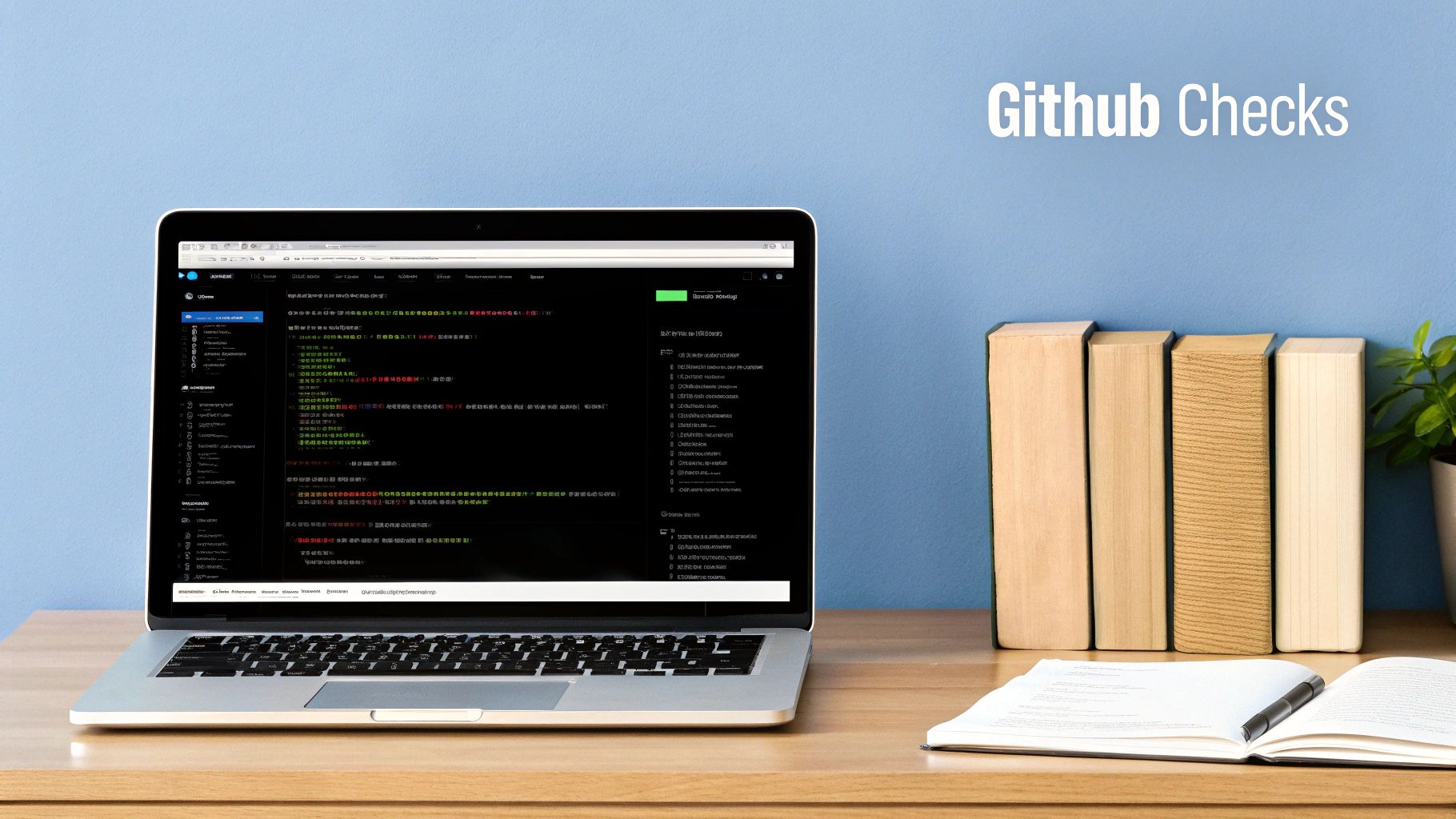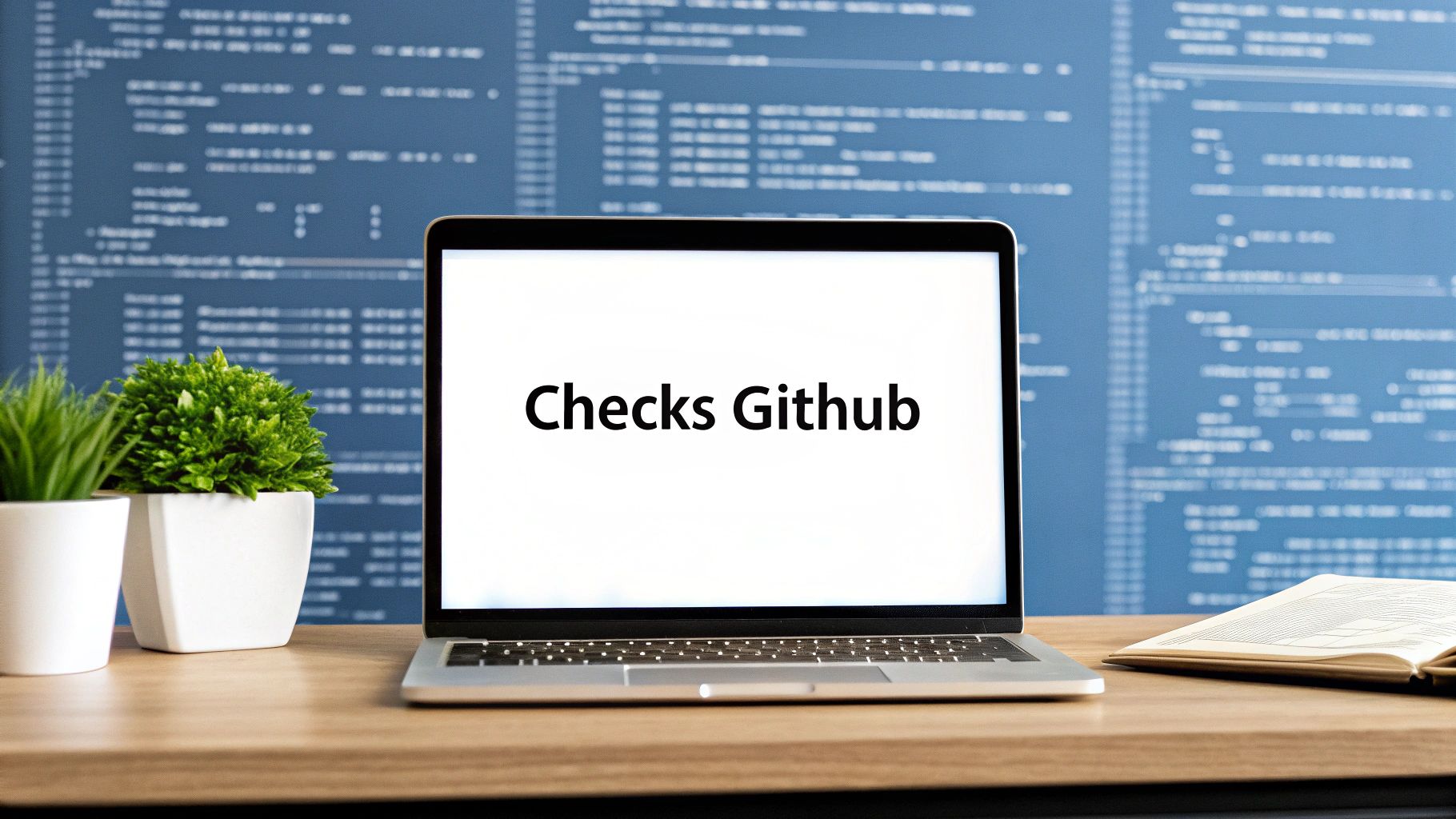Checks GitHub: Master Your Development Workflow
The Power of GitHub Checks: What Developers Need to Know

GitHub Checks are essential for modern software development. They act as automated gatekeepers, ensuring code quality and maintainability. Unlike simpler status checks that just show pass/fail, GitHub Checks offer rich contextual feedback. This includes annotations within the code itself, detailed logs, and links to external resources. This deeper level of information helps developers understand and fix issues quickly.
Key Advantages of GitHub Checks
Checks provide several advantages over traditional status checks. They can automate many tasks, like code linting, security scanning, and deployments to staging environments. Plus, they integrate seamlessly with GitHub's branch protection rules, allowing teams to enforce quality standards before code merges. This makes checks proactive tools for preventing problems, not just reacting to them.
-
Enhanced Feedback: Detailed reports and in-code annotations help developers identify and fix problems faster.
-
Automation: Automate tedious tasks, giving developers more time for complex coding work.
-
Branch Protection: Secure your codebase by enforcing quality checks before code reaches your main branch.
-
Integration: Integrate smoothly with popular CI/CD tools and customize them for your specific workflow.
The Growing Importance of Checks in a Collaborative World
As software development becomes increasingly collaborative, tools like GitHub Checks are more critical than ever. With more developers contributing to projects, ensuring consistent code quality is paramount. GitHub's user base has grown tremendously. By early 2023, the platform reached 100 million developers, with over 9 million in India alone. This demonstrates the global adoption of collaborative coding. Learn more about GitHub's growth and developer trends.
The increasing use of AI tools in development, with 94% of developers incorporating AI into their coding practices, further fuels this growth. This rise in users and project complexity makes automated quality tools like Checks vital for maintaining project health and developer productivity.
Checks and Team Efficiency
Teams using GitHub Checks often see significant improvements in their overall efficiency. However, poorly configured checks can create bottlenecks. Careful planning and implementation are essential for maximizing the benefits. This includes selecting appropriate checks, configuring timeouts, and creating clear communication about check failures.
By integrating checks into the development process, teams can cultivate a culture of quality and collaboration. This proactive approach improves code reliability and creates a more positive and productive environment.
Implementing Effective Status Checks in GitHub

Implementing robust checks in GitHub is crucial for maintaining code quality and streamlining your development workflow. This goes beyond a simple pass/fail system. It requires a strategic approach to branch protection rules and required checks. Think of these as preventative measures, stopping problematic code from merging into your main branches and acting as a gatekeeper for your project.
Setting Up Branch Protection
Protecting your main branch is the first line of defense. Within your GitHub repository settings, branch protection rules let you specify which checks must pass before any code can be merged. This guarantees that all code undergoes the required validation, catching potential issues early. For example, requiring a successful build check prevents code with compilation errors from reaching production.
Integrating With CI Services
GitHub checks seamlessly integrate with a variety of Continuous Integration (CI) services. Popular choices include GitHub Actions, CircleCI, and Travis CI. These services automate the execution of tests, code analysis, and other vital checks. The integration provides a single, unified view of your code's status directly within GitHub.
To help you choose the best CI for your needs, take a look at the comparison table below. It outlines the key features and complexities of the most commonly used CI services that work with GitHub checks.
To get a deeper understanding of setting up and configuring these integrations, check out this helpful guide: How to master GitHub status checks.
Popular CI Services for GitHub Checks
Comparison of the most widely used CI services that integrate with GitHub checks
| CI Service | Setup Complexity | GitHub Integration | Free Tier Features | Enterprise Features | |---|---|---|---|---| | GitHub Actions | Easy | Seamless | Generous build minutes and storage | Advanced security and compliance | | CircleCI | Moderate | Tight integration | Limited build minutes | Scalable infrastructure and dedicated support | | Travis CI | Moderate | Well-established integration | Open-source projects get free access | Enhanced build capacity and private dependencies |
As you can see, each CI service offers a different balance of features and complexity. Choosing the right one depends on your specific project requirements and budget.
Best Practices for Check Naming and Timeout Configurations
Clear and consistent check naming is vital for quickly grasping the purpose of each check. For instance, prefixing checks with categories like build:, test:, or security: improves readability. Also, configuring timeouts prevents checks from indefinitely blocking merges if a CI service encounters problems. Setting a reasonable timeout ensures developers aren’t stuck waiting.
Handling Check Failures
While preventing failures is the goal, planning for them is just as important. Clear communication channels and documented procedures enable your team to respond quickly to check failures. This includes steps for debugging, rerunning checks, and pinpointing the root cause.
Optimizing Developer Experience With Effective Checks
Well-implemented checks in GitHub greatly contribute to a positive developer experience. By automating repetitive tasks and offering clear feedback, checks free up developers to tackle more challenging coding problems. This boosts productivity and code quality. However, it's essential to find a balance between thorough validation and an efficient developer workflow. Overly restrictive or slow checks can cause frustration and bottlenecks.
By following the strategies outlined here, you can build a robust system of GitHub checks that strengthens your development process, improves code quality, and creates a better overall developer experience. This proactive approach leads to a more stable and efficient workflow, ultimately resulting in better software and faster delivery.
Security Checks GitHub: Bulletproofing Your Codebase

Security is no longer a final step in software development. It's woven into the entire process. This involves incorporating robust security checks directly into your GitHub workflow. These checks function like automated guardians, constantly monitoring your codebase for vulnerabilities. This proactive strategy is key to identifying and addressing risks before they escalate into major security incidents.
Leveraging GitHub's Native Security Tools
GitHub offers a set of built-in security tools that seamlessly integrate with your checks. These tools automate important security processes, simplifying the task of creating a strong security foundation.
For example, Dependabot automatically scans your project's dependencies for known weaknesses. This helps you stay one step ahead of potential attacks and maintain the security of your software.
CodeQL provides advanced code analysis capabilities that delve deeper than basic vulnerability scanning. It uses powerful querying methods to uncover complex security flaws that might otherwise be missed. This in-depth analysis gives you a comprehensive overview of your code's security status.
Protecting confidential information is paramount. GitHub's Secret Scanning helps avoid the accidental disclosure of passwords and API keys within your repositories. This essential feature automatically identifies and notifies you of any potentially exposed secrets, reducing the risk of unauthorized access.
Automating Security Checks and Remediation
Top development teams automate their security checks within GitHub. This automation ensures consistent application of security protocols and minimizes human error, fostering a proactive security environment. You might be interested in learning more about this: How to master GitHub compliance as code.
Setting up automated checks to run on every pull request, for instance, ensures new code is thoroughly examined for security vulnerabilities before merging it into the main branch. This also promotes rapid identification and resolution of security issues during the early stages of development.
Integrating Third-Party Security Tools
While GitHub's integrated security tools offer robust capabilities, incorporating third-party solutions can strengthen your security even further. This creates a defense-in-depth approach. Specialized security scanners, as an example, can be incorporated into your checks workflow to add extra layers of analysis and vulnerability detection.
Managing multiple security tools can sometimes result in an excessive number of alerts, including false positives. These false alarms can deplete valuable team resources. Therefore, efficiently prioritizing and filtering security alerts is essential for concentrating on genuine threats and making the most of remediation efforts. Prioritization strategies should account for factors such as vulnerability severity, the potential impact on your system, and the probability of exploitation.
The Business Case for Robust GitHub Checks
Establishing strong security practices isn't solely about technical excellence; it's also a crucial business decision. GitHub's own accomplishments highlight this. The platform boasts $1 billion in annual recurring revenue, a clear indicator of its value to businesses. Over 90% of Fortune 100 companies utilize GitHub's corporate services. Microsoft's $7.5 billion acquisition of GitHub in 2018 underscores GitHub's strategic significance in the tech world. More detailed statistics can be found here: https://www.enterpriseappstoday.com/stats/github-statistics.html.
By utilizing these GitHub security checks, you develop a more secure and resilient codebase. This not only safeguards your organization from potential breaches but also cultivates trust among users and stakeholders. This security-focused methodology demonstrates a dedication to industry best practices, ultimately contributing to the sustained success of your projects and organization.
Creating Custom Checks for Your Team's Needs in GitHub

While GitHub's pre-built checks offer a solid foundation, they may not always address every team's specific needs. This section explores creating custom checks tailored to your unique workflows, empowering your team to enforce standards and tackle domain-specific challenges that generic checks might miss.
Building Specialized GitHub Actions
GitHub Actions provides a powerful way to implement custom checks. These customizable workflows automate various tasks within your repository. For instance, you could create an action that runs a custom linting tool against your codebase, ensuring adherence to your team's specific coding style guidelines.
Beyond code style, Actions can automate deployments, execute integration tests, and perform any other task vital to your development lifecycle. This automation saves time and ensures consistency across your projects.
Implementing Repository-Specific Validation Rules
Custom checks in GitHub also allow you to define repository-specific validation rules. Consider a scenario where you're developing microservices and need to enforce specific API contract requirements.
A custom check can validate the contract during each pull request, ensuring consistency and preventing integration issues down the line. This approach is equally applicable to monolithic or hybrid architectures, providing a flexible way to enforce project-specific rules.
Writing Custom Check Runners With the Checks API
For more complex scenarios, the Checks API offers the flexibility to build fully customized check runners. This deep level of customization enables integrating checks with your existing tools and processes.
For example, if your team relies on a proprietary performance benchmarking tool, you can create a check runner that integrates with it, providing performance metrics alongside other standard checks. This gives you a comprehensive view of your code's quality and performance.
Real-World Implementation Examples
Here are a few examples of how custom checks can be applied in practice:
- Code Style Enforcement: Create a check to ensure code adheres to your team's style guide, promoting consistency and streamlining code reviews.
- Documentation Requirements: Enforce documentation standards with a check that validates documentation coverage or format.
- Performance Benchmarks: Implement a check that runs performance tests and flags any regressions, helping maintain performance standards throughout the development process.
- Domain-Specific Validations: Develop checks tailored to your specific business domain. This might include validating data formats, compliance requirements, or other specific needs.
By creating custom checks tailored to your team's specific requirements, you gain granular control over your development process. This allows you to enforce standards, address project-specific needs, and seamlessly integrate with existing workflows. Thoroughly documenting these custom checks is crucial, helping team members understand their purpose and configuration. Using tools like Pull Checklist can further streamline code reviews and enforce standards, providing a central hub for all checks and code validation tasks. This ensures quality and consistency throughout development, empowering your team to deliver high-quality code efficiently.
Troubleshooting GitHub Checks: Solving Common Headaches
Checks on GitHub are invaluable for ensuring code quality, but they can occasionally be a pain point. This section dives into common issues developers encounter with GitHub checks, providing solutions and preventative strategies.
Flaky Tests
Flaky tests, those that pass and fail intermittently without code changes, are a frequent source of frustration. They waste valuable developer time and erode confidence in the reliability of the checks themselves.
- Possible Causes: Network instability, timing discrepancies, dependencies on external services, or inconsistent test data can all contribute to flaky tests.
- Solutions: Isolate and quarantine flaky tests. Investigate the root cause and implement a fix. Consider using retry mechanisms in your Continuous Integration (CI) configuration to handle transient failures.
- Prevention: Write deterministic tests, mock external dependencies, and use robust test data management practices.
Timeout Issues
Resource-intensive checks, such as complex builds or extensive test suites, can sometimes exceed allocated time limits, resulting in timeouts. This halts the entire pipeline and can block merges.
- Possible Causes: Insufficient resources allocated to the CI runner, inefficient build processes, or long-running tests are potential culprits.
- Solutions: Increase timeout limits in your check configuration. Optimize your build processes and break down large tests into smaller, more manageable units. Consider using more powerful CI runners with increased resources.
- Prevention: Continuously monitor check execution times and proactively identify slow or resource-intensive checks. Optimize resource allocation based on the specific needs of each check.
Conflicts Between Check Services
Using multiple check services can sometimes lead to conflicts, particularly if they attempt to modify the same files or access shared resources. This can cause unpredictable check behavior and failed builds.
- Possible Causes: Overlapping functionalities of different check services, incompatible configurations, or resource contention can cause conflicts.
- Solutions: Clearly define the roles and responsibilities of each check service. Ensure their configurations are compatible and isolate their operations to prevent conflicts.
- Prevention: Carefully evaluate and select check services to avoid redundancy and potential conflicts. Establish a clear hierarchy for check execution to effectively manage dependencies.
Permission-Related Roadblocks
Checks can fail due to insufficient permissions to access required resources, such as repositories, secrets, or external systems. This often manifests as authentication errors or "access denied" messages.
- Possible Causes: Incorrectly configured access tokens, missing repository permissions, or improperly configured access control settings.
- Solutions: Review and update access tokens. Grant the necessary repository permissions to the CI user. Verify that access control settings are correctly configured.
- Prevention: Utilize fine-grained access control mechanisms to effectively manage permissions and implement a clear access policy for CI users. Regularly audit and update permissions to prevent future issues.
To help you diagnose and resolve these common issues, the following table provides a quick reference guide:
Common GitHub Checks Problems & Solutions
| Problem | Possible Causes | Solution Steps | Prevention Tips | |---|---|---|---| | Flaky Tests | Network blips, timing issues, dependencies on external services, inconsistent test data | Isolate and quarantine the test; Investigate the root cause and fix; Use retry mechanisms in CI configuration | Write deterministic tests; Mock external dependencies; Robust test data management | | Timeout Issues | Insufficient CI runner resources; Inefficient build processes; Long-running tests | Increase timeout limits in check configuration; Optimize build processes; Break down large tests into smaller units; Use more powerful CI runners | Continuously monitor check execution times; Optimize resource allocation based on check needs | | Conflicts Between Check Services | Overlapping functionalities; Incompatible configurations; Resource contention | Define roles and responsibilities for each check service; Ensure compatible configurations; Isolate operations | Carefully evaluate and select check services; Establish hierarchy for check execution | | Permission-Related Roadblocks | Incorrect access tokens; Missing repository permissions; Incorrect access control settings | Review and update access tokens; Grant necessary permissions to CI user; Verify access control settings | Use fine-grained access control; Implement clear access policy for CI users; Regularly audit and update permissions |
This table summarizes common problems encountered with GitHub checks, their potential underlying causes, recommended solutions, and preventative measures to avoid these issues in the future.
Implementing Logging and Reruns
Improve your GitHub checks workflow with effective logging and rerun strategies. Detailed logs provide valuable insights for faster debugging, while reruns can help bypass those pesky transient failures. Combining these strategies offers a robust approach to mitigating common GitHub checks headaches.
Utilizing Tools for Streamlined Checks
Tools like Pull Checklist streamline your GitHub checks process by automating checklist completion and enforcement directly within pull requests. This added layer of organization ensures essential checks are never overlooked and contributes to a smoother, more efficient workflow. This integration empowers teams to effectively manage checks, minimizing friction and maximizing productivity.
Mastering CI/CD With Advanced GitHub Checks
GitHub checks are more than just simple verifications. They form the bedrock of robust CI/CD pipelines that deliver significant business value. This section explores how successful development teams use these checks to create multi-stage workflows, balancing speed and quality.
Deployment Gates and Automated Approvals
Leading development teams use GitHub checks to implement deployment gates. This means deployments to specific environments, like staging or production, are automatically controlled based on the successful completion of defined checks. For instance, a production deployment might require passing all tests, code quality checks, and security scans. This ensures only validated code reaches end-users.
Checks can also automate approval processes. Imagine a senior developer needing to approve a critical change before deployment. GitHub checks can be configured to require this approval, streamlining the process and ensuring crucial oversight.
Progressive Delivery With Feature Flags and Canary Deployments
Progressive delivery techniques, such as feature flags and canary deployments, can be effectively managed with GitHub checks. Feature flags let you enable or disable features in production without deploying new code. Checks can verify the behavior of these flagged features before full rollout.
Canary deployments, where a new version is released to a small subset of users first, also benefit. Post-deployment checks monitor performance and error rates within this canary group. If issues arise, automated rollbacks, triggered by the checks, can prevent widespread problems.
Optimizing Check Performance and Managing Checks at Scale
As projects expand, efficient check management becomes crucial. Optimizing check performance minimizes delays and maintains smooth pipeline flow. This might involve parallelizing check execution, caching dependencies, or leveraging more powerful CI runners.
For more insights into streamlining your workflow, check out our guide on how to master developer productivity. Managing checks across multiple repositories or complex monorepos presents unique challenges. Strategies like shared check configurations and centralized reporting simplify management and enhance consistency, helping maintain quality and prevent check sprawl.
Real-World Examples of Advanced CI/CD Implementations
Consider a team developing a mobile app. They might implement a pipeline where checks play a central role:
- Code is pushed to a feature branch: Unit tests and linting checks run automatically using GitHub Actions.
- A pull request is opened: Code review is performed, triggering additional checks like security scanning and API contract validation.
- After merging to the main branch: Integration tests and UI tests are executed.
- Deployment to a staging environment: A canary deployment to a small user group is initiated. Performance and error monitoring checks run continuously.
- Deployment to production: Based on the successful canary deployment and senior developer approval, the code is fully released.
This example showcases how checks can orchestrate a complex CI/CD pipeline, guaranteeing quality and control at each stage.
Streamline your code review process with Pull Checklist, a GitHub Marketplace app that automates and manages checklists within pull requests. It helps maintain high-quality reviews, reduces mistakes, and enforces consistency, even in complex projects. Learn more about Pull Checklist and how it can enhance your workflow.
